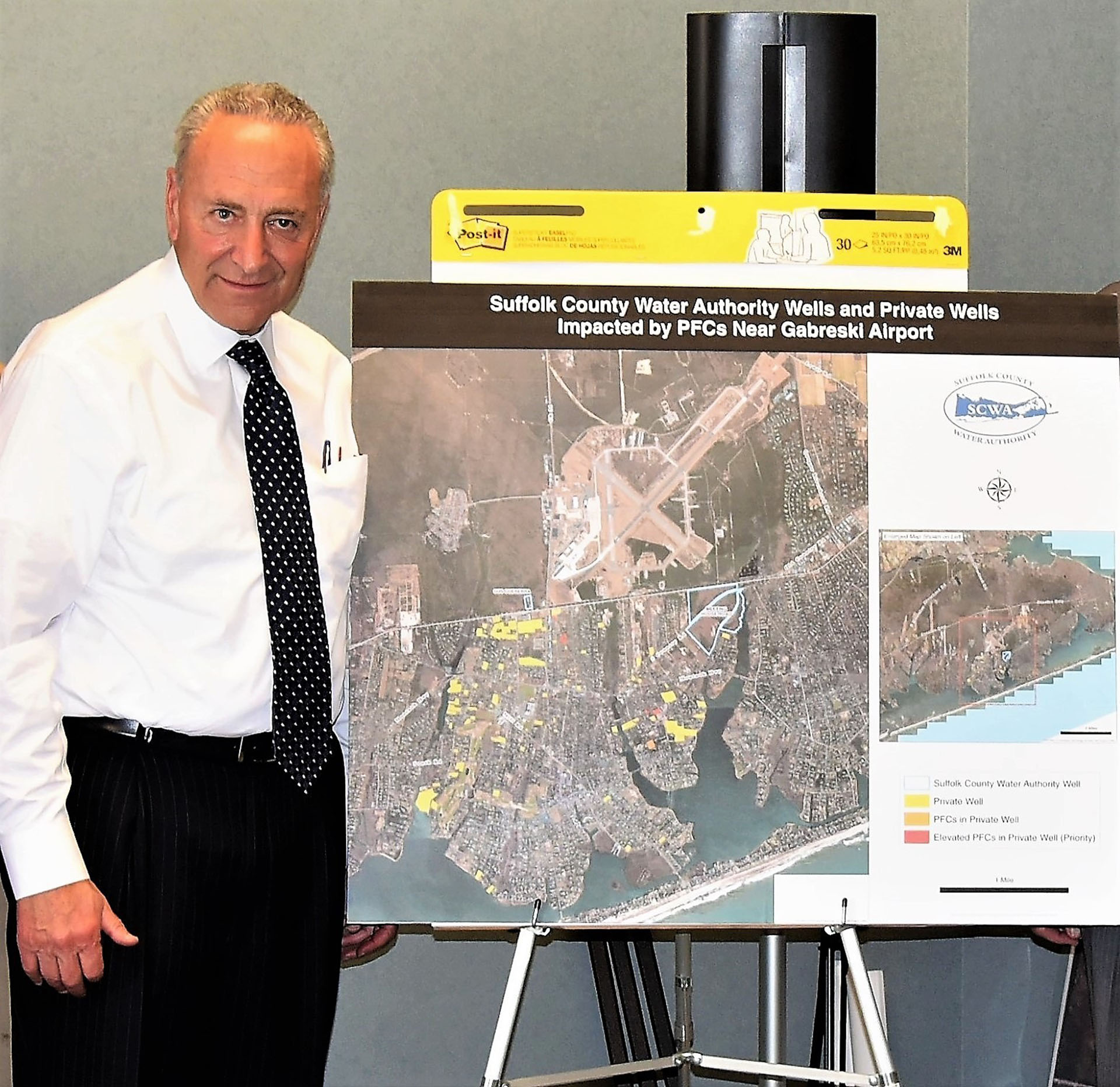Pentagon: We Concealed Contamination At Sites

The Pentagon has finally released information that U.S. Air Force bases all over the country were deliberately concealing the seepage of chemically-dangerous perfluorinated compounds into public drinking water through local wells.
It came in the form of a September announcement that the federal government will reimburse the Suffolk County Water Authority more than $4 million for the costs of cleaning up toxic firefighting foam contaminants at Francis S. Gabreski Airport in Westhampton Beach. As much as $4,022,731, to be exact, will go to the county as part of the federal National Defense Authorization Act of this year. The money was expected to arrive by October. The funds were part of a $20 million payout from the Air Force to local water authorities nationwide.
“Suffolk County and its water authority deserves to be repaid for the actions they took to respond to the contamination of their water supplies and private wells due to toxic PFOS, PFOA, and related chemicals of the PFC family to contamination that originated at Gabreski,” New York State Senator Chuck Schumer had said at a private gathering of Suffolk County officials briefed on the matter in 2017. The Independent was present at that gathering.
In November of that year the Suffolk County Water Authority filed a lawsuit against firefighting foam manufacturers, and in June, New York State sued six companies that manufactured the foam.
“No New Yorker should ever have to worry about whether their drinking water is going to make them sick, and it’s time for the federal government to do its part and reimburse communities like Westhampton Beach for this expensive cleanup,” state Senator Kirsten Gillibrand said in a release.
The payment arrives three years after National Guard Bureau Chief Richard P. McCoy wrote to county and water authority officials saying he thought fire training and suppression systems, which were used by the Air National Guard and Air Force at the base at Gabreski, had contaminated area drinking water wells. The admittance to the PFCs, labeled more specifically now by the U.S. Environmental Protection Agency as per- and polyfluoroalkyl substances, comes after repeated prodding — much of it done by Schumer. It confirms The Independent’s 2016 exposé that the Pentagon hid the extent of the problem.
Officials “think there are probably more installations, and I’m not ready to tell you what that number is, but we found that we undercounted,” Assistant Secretary of Defense for Sustainment Robert McMahon said November 27, according to the Military Times. The retired United States Air Force major general said the department will name the sites when it has verified the number and locations.
The Independent noted bases in Randolph, TX; Robins, GA; Beale, CA; McClellan, CO; Eglin, FL; Ellsworth, SD; and Cheyenne, WY, all had similar leakage problems discovered as early as 2013, but the Air Force neglected to make a connect base-by-base studies to see if there was a common thread.
After discovering in 2013 Gabreski airport had perfluorooctane sulfonic acid and perfluorooctanoic acid, referred collectively as PFAS because they belong to that family, detected in the groundwater, the parcel was labeled a Superfund site. Although that designation did not come until September 2016, it was known that firefighting foam used when the location was a Department of Defense training facility. Suffolk County authorities switched more than 60 homes over from private wells to public water sources as a result.
Schumer and Gillibrand at the time had also pointed to contamination at Stewart Air National Guard base in Orange County, which was declared a Superfund site just months earlier, in August.
The Pentagon helped develop the firefighting foam in the 1960s with the chemicals that have been known to be toxic since the 1980s. The compounds PFOS and PFOA, found commonly in small doses in stain-resistant furniture, microwave popcorn bags, cosmetics, and household cleaners, in high doses can cause liver, pancreatic, testicular, and mammary gland tumors, kidney damage, and reproductive problems. The Damascus Road landfill in East Quogue had levels 150 times the federal health advisory limit in February of 2018, which was being studied by Southampton Town to see if the levels detected were a result of runoff from the airport site. That landfill also runs the risk of being declared a Superfund site.
A study by the Department of Health and Human Services even concluded: “These chemicals pose a danger to humans at far lower levels than the EPA said was safe.”
According to the Environmental Working Group, the Pentagon failed to alert service members. The problem is mushrooming as testing becomes more frequent. The contaminated compounds are popping up all over the country, and in the past two years were also detected in Hampton Bays, Wainscott, and Yaphank.
Schumer and Gillibrand have complained the Trump administration is hiding information from the public about the dangers of PFAS “because they are scared that Americans will be angry,” Gillibrand said. “Numerous communities in New York have already had their water supplies poisoned by these very chemicals, and if the Trump administration has more evidence that PFAS are harmful to people’s health, then they need to come clean and tell the public.”
rmurphy@indyeastend.com



